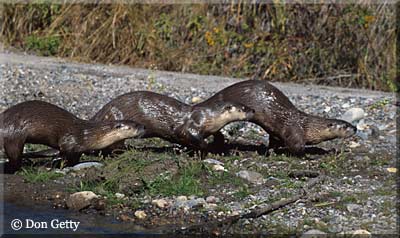
July 13, 2007

Don Getty, River Otters, Grand Tetons. Used with full permission of Mr. Getty. The photograph does not, however, appear in Ben’s and Joe’s book from last year. Would it have helped lessened the blow of this review against their flank?
One would expect that the respected Journal of Folklore Reseach at Indiana University would come down on the side of Benjamin Radford’s and Joe Nickell’s recent skeptical book, Lake Monster Mysteries: Investigating the World’s Most Elusive Creatures.
It turns out it didn’t work out that way, and the journal, instead, found the book had shortcomings. Did Ben and Joe receive the shaft from Indiana’s JFR? Or a fair review?

As the name suggests, the book Lake Monster Mysteries is grounded in cryptozoology and as such is one that deals with the legendary creatures that supposedly inhabit the lakes and lochs across the globe. The possibility that a broad spectrum of creatures exists in these bodies of water is dealt with through interview, reportage, and document analysis. The case-study approach includes a focus on the more well known leviathan forms such as the Loch Ness Monster and the lesser known examples such as those inhabiting the depths in bodies of water in Turkey and South America.
In more specific terms, as stated in the introduction to this book, the purpose of the text is to provide an account of serious investigation as opposed to a collection of “enticing and amusing” narratives that characterizes other books dealing with this topic. On page eight of this section, the authors claim that the book is unique in this respect, as it demonstrates a “much needed scientific rigour and scholarship to a field better known for its wild, unsubstantiated claims than its careful examination of the facts.” It is in this facet that the book falls short.
The text is comprehensive in that it deals with numerous creatures on a global scale on a case-by-case basis, and it utilizes a mostly rigorous qualitative approach in its data collection. However, while the individual case studies of “close encounters” with these creatures are described in relative detail and the first-hand data as provided by apparent observers and photographers are clearly spelt out in a well constructed report format that carefully weaves in emic and etic descriptors, overall it fails to meet the intent of scientific rigor. The occasional comment by the authors clearly reveals a lack of understanding of the paradigm they chose to use. A case in point is the authors’ claim on page one hundred and sixty four that if data-collection details of all first-hand sightings could occur, then the research would be statistically and scientifically valid. This is not the ontological purpose or epistemological function of case-study investigations, or indeed of qualitative research.
The lack of understanding of how to collect, unpack, and make sense of observational and reportage data is further revealed in the findings and conclusions at the end of each section and in the concluding chapters of this book. After providing examples of interviews, document analysis, and photographic evidence, the analysis and conclusions fall into the category of “stating the obvious” or a recount of the observational methods employed. What is needed, as suggested in a fleeting remark by the authors, is a focused analysis on the psychological reasons as to why these reports of mysterious creatures have surfaced and continue to do so across time and cultures. There is no attempt to compare, contrast, or explain in any depth the transtextual narratives the authors utilized or the data they unearthed. Description in the guise of analysis is a trap that continues to haunt this form of investigation. Thus, while having the best intentions and coming tantalizingly close to their purpose, the authors have simply recreated a set of “enticing and amusing” narratives that have a paratextual and archetextual similarity to The X Files. Review by Phil Fitzsimmons, University of Wollongong, Australia, of Lake Monster Mysteries: Investigating the World’s Most Elusive Creatures by Benjamin Radford and Joe Nickell. Journal of Folklore Research, posted on July 12, 2007]
About Loren Coleman
Loren Coleman is one of the world’s leading cryptozoologists, some say “the” leading living cryptozoologist. Certainly, he is acknowledged as the current living American researcher and writer who has most popularized cryptozoology in the late 20th and early 21st centuries.
Starting his fieldwork and investigations in 1960, after traveling and trekking extensively in pursuit of cryptozoological mysteries, Coleman began writing to share his experiences in 1969. An honorary member of Ivan T. Sanderson’s Society for the Investigation of the Unexplained in the 1970s, Coleman has been bestowed with similar honorary memberships of the North Idaho College Cryptozoology Club in 1983, and in subsequent years, that of the British Columbia Scientific Cryptozoology Club, CryptoSafari International, and other international organizations. He was also a Life Member and Benefactor of the International Society of Cryptozoology (now-defunct).
Loren Coleman’s daily blog, as a member of the Cryptomundo Team, served as an ongoing avenue of communication for the ever-growing body of cryptozoo news from 2005 through 2013. He returned as an infrequent contributor beginning Halloween week of 2015.
Coleman is the founder in 2003, and current director of the International Cryptozoology Museum in Portland, Maine.
Filed under Books, Breaking News, Cryptomundo Exclusive, Cryptotourism, CryptoZoo News, Cryptozoologists, Cryptozoology, Folklore, Lake Monsters, Loch Ness Monster, Ogopogo, Reviews, Sea Serpents